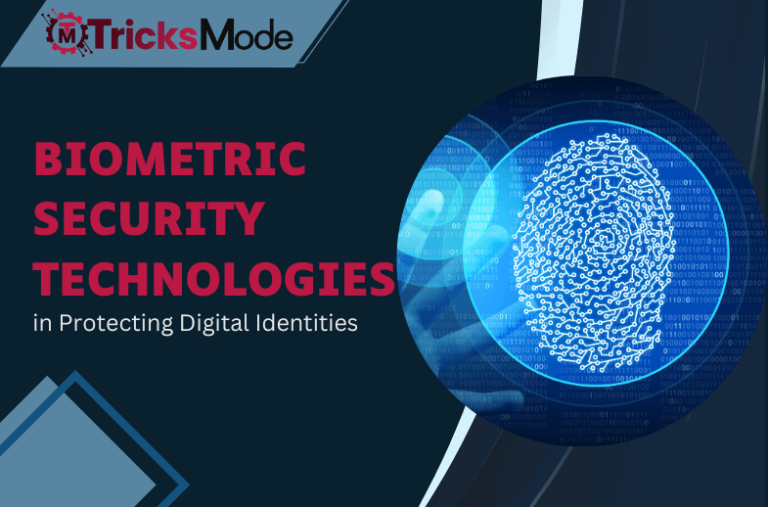Biometric security technologies have changed how we keep our digital assets secure. These technologies are proven tools to protect our digital assets and identity in a deeply interconnected world. Biometric technologies introduce biometrical characteristics, such as facial recognition, fingerprint scanner and voice recognition, to verify identities and grant access. With every passing day, cybercriminals and hackers are working to sharpen their skills to access your digital assets. Therefore, you should implement biometric security technologies to secure your digital identities.
In this article, we will talk about biometric security technologies for protecting digital identities.
What Is Biometric Security?
Biometric security involves advanced software to identify people depending on their biological and behavioral characteristics. It compares a person’s biometric data to their registered data, known as a template, to identify the resemblance between both. The commonly used biometric security software is fingerprint recognition because of its low pricing.
Read Also: Insights and Assurance: Exploring Cybersecurity Blogs and Opinions
Benefits Of Biometric Security Technologies
Biometric security has various benefits because it provides an efficient way to secure digital assets. Here are some significant benefits of biometric security:
- Faster Authentication: A user can easily and quickly authenticate desired applications with biometrics. It is easy to authenticate an individual quickly using a face or finger scanner.
- Convenient: Businesses can store employees’ attendance data in a sheet or database using hand geometry biometrics or fingerprint scanner in the office.
- Accuracy: The data gathered from biometrics is more accurate than other sources. It shows the exact time when an employee entered or left the office.
- Flexibility: Biometrics are so flexible that a company has not need to maintain a long attendance sheet to store data. In addition, employees also do not need to worry about repeatedly putting login passwords in their systems.
- Scalability: The scalability of biometrics is unreachable. Businesses or individuals can use biometrics for their purposes and projects.
- Access Control: Biometric access control is a type of digital entrance system capable of controlling physical access to a specific place.
- Secure: Hackers and other identity thieves can not steal biometrics by observing them. Therefore, biometric security technologies are way more secure.
Biometric Security Technologies in Securing Digital Identities
Biometric Security technologies make securing digital assets easy and efficient. Here you can get some biometric security technologies to protect digital identities:
Fingerprint Scanners
Fingerprint scanning is used in a vast range because of its affordability, relatable accuracy and security. A fingerprint scanner provides a digital print of the finger and the computer converts it into a code using pattern-matching software. Then, the code is compared to the database of registered identities to approve access. Most companies use fingerprint scanners to prevent hackers.
Facial Recognition
Facial recognition is a widely used biometric security technology because it accurately identifies an individual. These facial terminals capture your face using HDR and IR cameras. The features, such as the distance of eyes from the forehead and the mouth, are compared with registered facial features via specialized cameras. Organizations use facial recognition technology to ensure their digital assets are safe and no one without permission can access that.

Voice Recognition
Voice recognition is a process in which the user’s voice is used to identify the claimed identity. The speaker’s voice is compared with the voice print to allow access if it is a 1:1 match. These security systems usually give access to protect systems like telephone banking. A safe telephone banking system is possible via voice biometrics, which allows speakers to register their voice as a template and each time, your voice will be compared to the template for further process.
Vein Recognition
This technology allows security software to compare the pattern of veins in an individual’s palm and fingers to permit access. It is also known as vascular biometrics. These security systems are often used in jails and security companies. It uses near-infrared waves to seek images of veins from an individual’s hand or fingers for recognition. Many hospitals, industries and highly sensitive areas use vein recognition technology to avoid the forgery of identity cards.
Hand Geometry
In hand geometry biometrics, the geometric features of an individual’s hand are scanned and compared to a registered template to give access to the system. The features may include the distance between fingers. This technology is being used widely for applications in physical access, personal verification and attendance tracking. Businesses use hand geometry recognition technology to count or record their employees’ attendance. In addition, they are also able to track when an employee is entered or leaves the office.
Conclusion
Biometric security technologies are revolutionizing the way we protect our digital identities. It also enhanced the security of our digital assets like images, videos, infographics and voice media. The combined security of your physical or behavioral characteristics with different authentications provides an extraordinary and the strongest known security. At least, it is better than using a character-based password as a standalone verification. Biometrics provides very compelling solutions for security problems. These systems are hard to duplicate and more convenient. In addition, they will continue to develop for a very long time.


